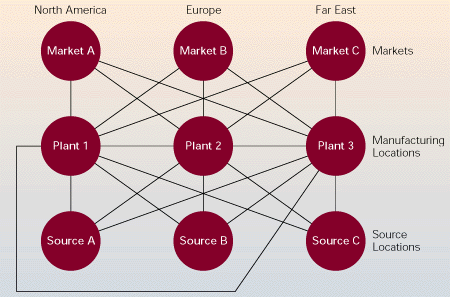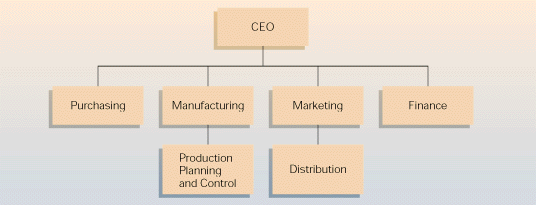Texts belong to their owners and are placed on a site for acquaintance.
Coordinating a Global Manufacturing System
Materials management, which encompasses logistics, embraces the activities necessary to get materials to a manufacturing facility, through the manufacturing process, and out through a distribution system to the end user.20 The twin objectives of materials management are to achieve this at the lowest possible cost and in a way that best serves customer needs, thereby lowering the costs of value creation and helping the firm establish a competitive advantage through superior customer service.
The potential for reducing costs through more efficient materials management is enormous. For the typical manufacturing enterprise, material costs account for between 50 and 70 percent of revenues, depending on the industry. Even a small reduction in these costs can have a substantial impact on profitability. According to one estimate, for a firm with revenues of $1 million, a return on investment rate of 5 percent, and materials costs that are 50 percent of sales revenues, a $15,000 increase in total profits could be achieved either by increasing sales revenues 30 percent or by reducing materials costs by 3 percent. 21 In a saturated market, it would be much easier to reduce materials costs by 3 percent than to increase sales revenues by 30 percent.
Materials management is a major undertaking in a firm with a globally dispersed manufacturing system and global markets. Consider the example of Bose Corporation, which is presented in the accompanying Management Focus. Bose purchases component parts from suppliers scattered over North America, Europe, and the Far East. It assembles its high - fidelity speakers in Massachusetts and ships them to customers the world over. Bose's materials management function must coordinate the flow of component parts so they arrive at the assembly plant just in time to enter the production system. Then it must oversee the timely distribution of finished speakers to customers around the globe. These tasks are complicated by the vast distances involved and by the fact that component parts and finished products are shipped across national borders, where they must pass customs. As explained in the Management Focus, from time to time Bose must interrupt the normal supply chain to accelerate the delivery of essential components to respond to sudden upsurges in demand for Bose's products.
The Power of Just-in-Time
Pioneered by Japanese firms during the 1950s and 60s, just-in-time inventory systems now play a major role in most manufacturing firms. The basic philosophy behind just-in-time (JIT) systems is to economize on inventory holding costs by having materials arrive at a manufacturing plant just in time to enter the production process and not before. The major cost saving comes from speeding up inventory turnover; this reduces inventory holding costs, such as warehousing and storage costs.
In addition to the cost benefits, JIT systems can also help firms improve product quality. Under a JIT system, parts enter the manufacturing process immediately; they are not warehoused. This allows defective inputs to be spotted right away. The problem can then be traced to the supply source and fixed before more defective parts are produced. Under a more traditional system, warehousing parts for months before they are used allows many defective parts to be produced before a problem is recognized.
The drawback of a JIT system is that it leaves a firm without a buffer stock of inventory. Although buffer stocks are expensive to store, they can tide a firm over shortages brought about by disruption among suppliers (such as a labor dispute). Buffer stocks can also help a firm respond quickly to increases in demand. However, there are ways around these limitations. To reduce the risks associated with depending on one supplier for an important input, some firms source these inputs from several suppliers. As for responding quickly to increases in consumer demand, the experience of Bose Corporation shows that it is possible to do this while maintaining a JIT system, even if it involves shipping component parts by air rather than overland or by ship (see the Management Focus).
The Role of Organization
As the number and dispersion of domestic and foreign markets and sources grow, the number and complexity of organizational linkages increase correspondingly. In a multinational enterprise, the challenge of managing the costs associated with purchases, currency exchange, inbound and outbound transportation, production,
Figure 16.3
Potential Materials Management Linkages

inventory, communication, expediting, tariffs and duties, and overall administration is massive. Figure 16.3 shows the linkages that might exist for a firm that sources, manufactures, and sells internationally. Each linkage represents a flow of materials, capital, information, decisions, and people. The firm must figure out the best organization to achieve tight coordination of the various stages of the value creation process.
A major requirement seems to be to legitimize materials management by separating it out as a function and giving it equal weight, in organizational terms, with other more traditional functions such as manufacturing, marketing, and R&D. According to materials management specialists, purchasing, production, and distribution are not separate activities but three aspects of one basic task: controlling the flow of materials and products from sources of supply through manufacturing and distribution into the hands of customers.
Despite the apparent cost and quality control advantages of having a separate materials management function, all firms do not operate with such a function.22 Those that do not include many firms in which purchasing costs, inventories, and customer service levels are important, interdependent aspects of establishing competitive advantage. Such firms typically operate with a traditional organizational structure similar to the one in Figure 16.4a. In such an organization, purchasing, production planning and control, and distribution are not integrated. Planning and control are part of the manufacturing function, while distribution is part of the marketing function. Such companies will be unable to establish materials management as a major strength and consequently may face higher costs. Figure 16.4b shows the structure of a typical organization in which materials management is a separate function. Purchasing, planning and control, and distribution are integrated within the materials management function. Such an arrangement allows the firm to transform materials management into an important strength.
Having established the legitimacy of materials management, the next dilemma is determining the best structure in a multinational enterprise. In practice, authority is either centralized or decentralized.23 Under a centralized solution, most materials

Figure 16.4A
Traditional Organizational Structure

Figure 16.4B
Organization Structure with Materials Management at Separate Function
management decisions are made at the corporate level, which can ensure efficiency and adherence to overall corporate objectives. This is the case at Bose Corporation, for example. In large, complex organizations with many manufacturing plants, however, a centralized materials management function may become overloaded and unable to perform its task effectively. In such cases, a decentralized solution is needed.
A decentralized solution delegates most materials management decisions to the level of individual manufacturing plants within the firm, although corporate headquarters retains responsibility for overseeing the function. The great advantage of decentralizing is that it allows plant-level materials management groups to develop the knowledge and skills needed for interacting with foreign suppliers that are important to their particular plant. This can lead to better decision making. The disadvantage is that a lack of coordination between plants can result in less than optimal global sourcing. It can also lead to duplication of materials management efforts. These disadvantages can be attenuated, however, by information systems that enable headquarters to coordinate the various plant-level materials management groups.
The Role of Information Technology
As we saw in the Management Focus on Bose Corporation, information systems play a crucial role in modern materials management. By tracking component parts as they make their way across the globe toward an assembly plant, information systems enable a firm to optimize its production scheduling according to when components are expected to arrive. By locating component parts in the supply chain precisely, good information systems allow the firm to accelerate production when needed by pulling key components out of the regular supply chain and having them flown to the manufacturing plant.
Firms increasingly use electronic data interchange to coordinate the flow of materials into manufacturing, through manufacturing, and out to customers. EDI systems require computer links between a firm, its suppliers, and its shippers. Sometimes customers also are integrated into the system. These electronic links are then used to place orders with suppliers, to register parts leaving a supplier, to track them as they travel toward a manufacturing plant, and to register their arrival. Suppliers typically use an EDI link to send invoices to the purchasing firm. One consequence of an EDI system is that suppliers, shippers, and the purchasing firm can communicate with each other with no time delay, which increases the flexibility and responsiveness of the whole supply system. A second consequence is that much of the paperwork between suppliers, shippers, and the purchasing firm is eliminated. Good EDI systems can help a firm decentralize materials management decisions to the plant level by giving corporate-level managers the information they need for coordinating and controlling decentralized materials management groups.